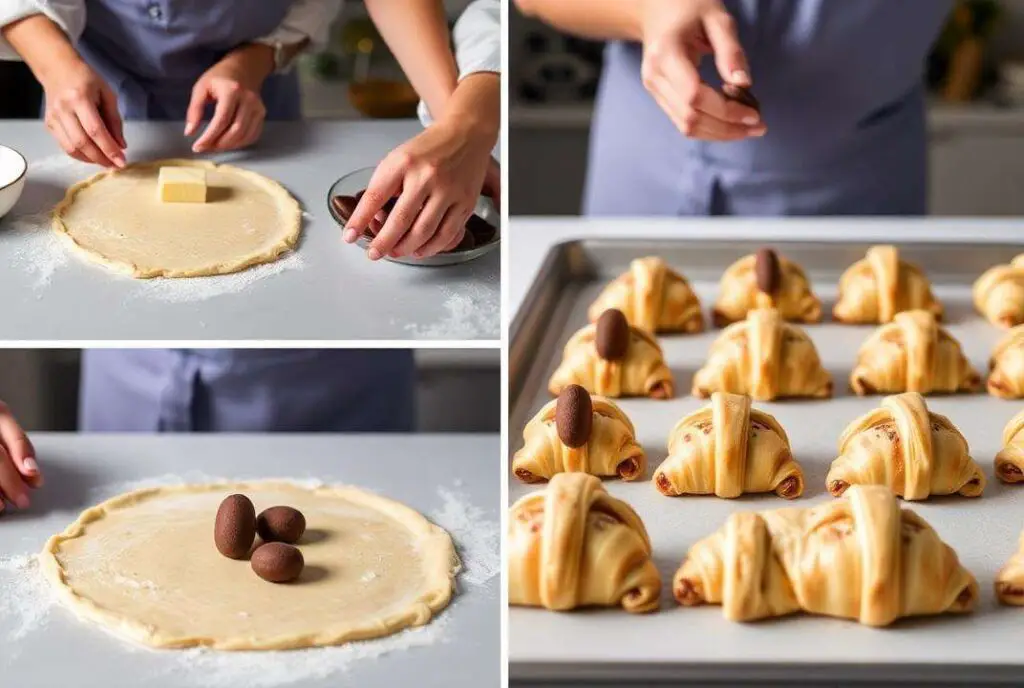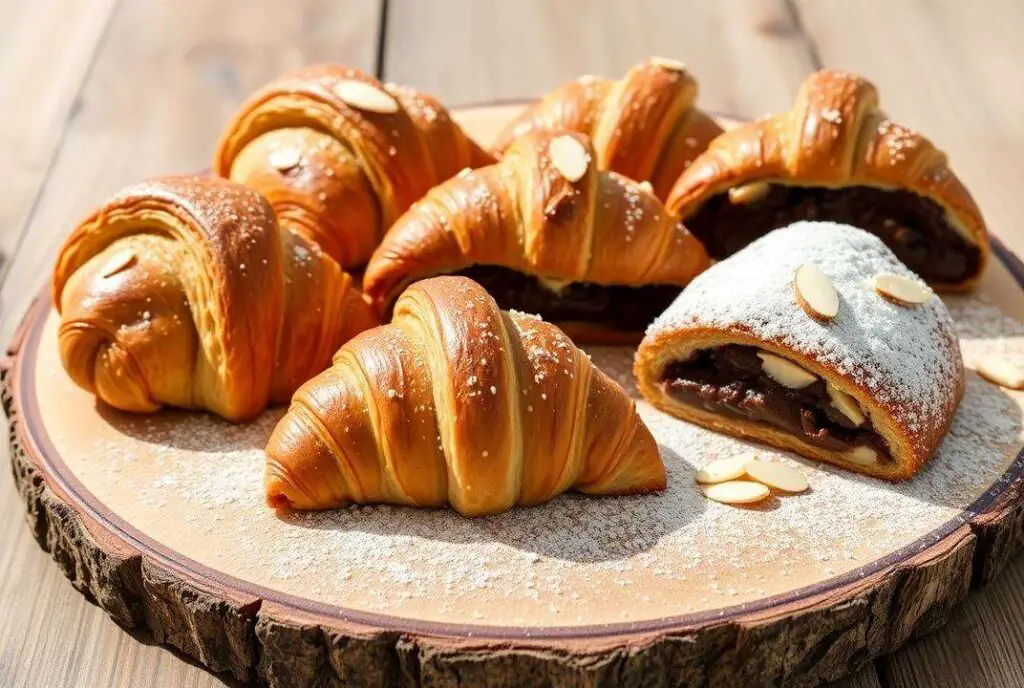There’s something magical about the perfect chocolate croissant. Flaky, buttery layers wrapped around rich, velvety chocolate—it’s a treat that transcends borders and tastes. Whether you’re savoring a freshly baked croissant at a Parisian café or heating up a store-bought version from Trader Joe’s, the allure of this classic pastry is universal.
This guide dives into the world of chocolate croissants, exploring their history, how to make them, where to find the best ones, and what makes them so irresistible. From understanding the delicate art of lamination to discussing variations like almond or vegan croissants, this article will satisfy your curiosity (and your cravings). Let’s start by uncovering what exactly a chocolate croissant is and why it’s so beloved.
Table of Contents
What Are Chocolate Croissants?
What is a Chocolate Croissant Called?
The name chocolate croissant might conjure visions of French bakeries, but in France, this delightful pastry is more commonly called pain au chocolat. The difference in naming boils down to cultural and linguistic preferences. In France and much of Europe, pain au chocolat is the go-to term, meaning “bread with chocolate.”
However, in English-speaking countries like the United States, people often call it a chocolate croissant. Why? Likely because of its crescent-shaped relative—the traditional butter croissant. Americans are so familiar with croissants that any pastry sharing the same dough is casually lumped under the croissant umbrella.
A Brief History of Chocolate Croissants
While the croissant itself has roots in Austria, where it was inspired by the kipferl in the 17th century, the chocolate croissant is an entirely French innovation. In the early 19th century, French bakers began laminating dough to create the airy, flaky texture we know today. Adding sticks of chocolate—known as batons—to the dough was a stroke of genius that elevated this humble pastry into a decadent delight.
As the croissant gained international fame, the chocolate-filled version followed. Today, it’s a staple in bakeries around the world, from bustling Paris streets to local grocery stores.
Cultural Importance of Chocolate Croissants
In France, pain au chocolat is more than just a snack; it’s a cultural icon. You’ll often find it accompanying a cup of espresso in a bustling café or wrapped in wax paper for an on-the-go breakfast. Children in France grow up with chocolate croissants as a staple treat, often enjoying them after school with a glass of milk.
But the popularity of chocolate croissants isn’t confined to Europe. Across the globe, this pastry represents indulgence and sophistication. Whether eaten warm from the oven or picked up from a store shelf, it’s the kind of treat that feels like a little slice of luxury in every bite.
The Art of Making Chocolate Croissants
Ingredients Needed for Authentic Chocolate Croissants
Creating chocolate croissants at home begins with selecting the finest ingredients. The magic lies in the dough’s richness and the chocolate’s quality. For the dough, a combination of all-purpose flour, unsalted butter, sugar, salt, and active dry yeast forms the base. High-fat butter, specifically European-style, is ideal for achieving that signature flaky texture.
The chocolate filling is equally crucial. Pastry chefs recommend using dark chocolate batons—thin, rectangular pieces of high-quality chocolate made specifically for croissants. Alternatively, dark chocolate chips or chopped chocolate with at least 70% cocoa content will work beautifully.
Finally, don’t forget the egg wash! A simple mix of beaten eggs and a splash of milk gives croissants their golden, glossy finish.
Step-by-Step Guide to Baking
Making chocolate croissants from scratch is an art, but with patience, anyone can master it.
- Prepare the Dough: Combine dry ingredients, gradually mix in milk, and knead until smooth. Let the dough rest in the fridge.
- Laminate the Dough: Roll the chilled dough into a rectangle and layer with butter. Fold and roll several times to create flaky layers.
- Shape and Fill: Cut the dough into rectangles, place a chocolate baton at one end, and roll tightly.
- Proof and Bake: Let the rolled croissants rise until puffy. Brush with egg wash, then bake at 375°F until golden brown.

Homemade croissants may require effort, but the payoff is extraordinary. Warm, flaky, and filled with melted chocolate, these pastries are worth every step.
Common Mistakes When Making Chocolate Croissants
Even seasoned bakers face challenges when making chocolate croissants. Here are a few pitfalls to avoid:
- Over-proofing the dough: This can lead to deflated, overly dense croissants. Keep a close eye on proofing times.
- Using inferior butter or chocolate: The flavor of your croissants depends on the quality of the ingredients. Cheap substitutes will yield lackluster results.
- Skipping the lamination process: Laminating the dough ensures the signature flaky texture. Don’t rush this step!
Top Chocolate Croissants Worldwide
Famous Bakeries and Cafés Known for Chocolate Croissants
Some of the world’s best chocolate croissants can be found in Paris, the birthplace of pain au chocolat. Legendary patisseries like Ladurée and Pierre Hermé offer croissants with perfectly layered dough and decadent chocolate fillings. Similarly, Boulangerie Poilâne is renowned for its artisanal approach to pastries.
Outside of France, New York City’s Dominique Ansel Bakery has gained global fame for its innovative creations, including its exquisite croissants. Los Angeles boasts Republique, a bakery known for its rich, buttery pastries. Whether in Europe or the United States, finding a high-quality chocolate croissant is always a worthwhile adventure.
Best Store-Bought Chocolate Croissants
If you’re not near a bakery, don’t worry—store-bought options have come a long way. According to rankings from food enthusiasts, Trader Joe’s frozen chocolate croissants are a favorite. They’re easy to bake at home, delivering a crispy crust and gooey chocolate center.
Other highly-rated options include Costco’s Kirkland Signature croissants, which are generously filled with chocolate and perfect for larger families. Whole Foods also offers gourmet chocolate croissants in their bakery section, often rivaling those from professional patisseries.
When selecting store-bought croissants, pay attention to the ingredients. Croissants made with real butter and chocolate—not substitutes—will taste far superior.
Chocolate Croissant Variations
Twists on the Classic Chocolate Croissant
While traditional chocolate croissants are hard to beat, bakers worldwide have added their own spins to this beloved treat. One popular twist is the almond chocolate croissant, which combines rich chocolate with a creamy almond paste filling. Topped with powdered sugar and sliced almonds, it’s a decadent indulgence.
For those seeking even more flavor, some bakeries offer hazelnut chocolate croissants. These versions often include a filling made from chocolate-hazelnut spread, like Nutella, and appeal to fans of sweet and nutty flavors.
Another creative option is the triple chocolate croissant, featuring chocolate dough, chocolate filling, and a drizzle of chocolate glaze on top. It’s a dream come true for chocolate lovers.
For more fun twists on classic recipes, check out Sophia’s Meals’ Chocolate Gravy Recipe, which offers another way to enjoy chocolate in your breakfast treats.

Regional Takes on Chocolate Croissants
Across the globe, chocolate croissants have been adapted to fit local tastes. In the United States, oversized versions with extra chocolate filling are common, offering a sweeter, richer bite.
In Spain and Italy, smaller, bite-sized croissants known as mini pains au chocolat or cornetti al cioccolato are often enjoyed as snacks or breakfast accompaniments. These lighter, portable versions are perfect for eating on the go.
Even vegan and gluten-free options are now widely available, making chocolate croissants accessible to everyone. Bakers use plant-based butter and alternative flours to recreate the classic taste without compromising texture or flavor.
Chocolate Croissants vs. Traditional Croissants
What Sets Chocolate Croissants Apart?
The biggest difference between chocolate croissants and their traditional counterparts is, of course, the filling. While regular croissants rely solely on buttery, flaky layers for their appeal, chocolate croissants add a rich, sweet dimension with their gooey chocolate center.
The shape also varies slightly. Traditional croissants are crescent-shaped, but chocolate croissants are typically rectangular to accommodate the chocolate batons tucked inside. This practical design ensures an even distribution of chocolate in every bite.
Texture-wise, both pastries share a similar flaky, layered structure due to their laminated dough. However, the inclusion of melted chocolate in chocolate croissants creates an additional element of indulgence.
Nutritional Comparisons
When it comes to calories and sugar content, chocolate croissants are naturally a bit heavier. The chocolate filling adds sugar and fat, making them a treat best enjoyed in moderation. A regular croissant averages around 230 calories, while a chocolate croissant can range from 280 to 350 calories, depending on the size and amount of chocolate used.
Despite the slight nutritional differences, both pastries share the same buttery richness and satisfying crunch. Whether you’re indulging in a plain croissant or treating yourself to its chocolate-filled cousin, you’re in for a delicious experience.
FAQs on Chocolate Croissants
What Is a Chocolate Croissant Called?
In France, chocolate croissants are famously known as pain au chocolat. The name translates to “bread with chocolate,” highlighting their deliciously simple composition. However, in English-speaking countries, the term chocolate croissant is more common, reflecting its flaky, buttery dough that’s shared with traditional croissants.
The difference in names often sparks debates, with some insisting on the authenticity of pain au chocolat. But no matter what you call it, this pastry remains a universal delight.
Does Trader Joe’s Have Chocolate Croissants?
Yes! Trader Joe’s chocolate croissants are a cult favorite among pastry lovers. Found in the frozen section, they’re easy to prepare at home. Simply proof the dough overnight, pop it in the oven, and enjoy fresh, flaky croissants in the morning. Fans rave about their buttery layers and the gooey chocolate center, making them a convenient and affordable treat.
Why Do Americans Call It a Chocolate Croissant?
The term chocolate croissant likely became popular in the U.S. due to its similarity to the traditional crescent-shaped croissant. Americans associate the laminated dough with croissants, regardless of shape or filling. While some purists prefer pain au chocolat, the name chocolate croissant has become widely accepted.
What Is the Difference Between Chocolate Croissants and Croissants?
The main difference is the filling. While traditional croissants are plain, chocolate croissants are filled with rich chocolate, offering a sweeter, more indulgent experience. Additionally, their shape differs—chocolate croissants are rectangular to hold the chocolate securely.
Why Everyone Loves Chocolate Croissants
Psychological and Sensory Appeal
It’s no wonder chocolate croissants are adored worldwide. The combination of buttery, flaky pastry and rich, melted chocolate creates a sensory experience that’s hard to resist. Each bite offers a perfect balance of crispiness, creaminess, and sweetness, making it an instant mood booster.
Studies suggest that the indulgent texture and flavor of chocolate trigger the release of feel-good hormones like serotonin. Coupled with the comforting aroma of freshly baked pastry, chocolate croissants offer a truly joyful experience.
Popularity in Media and Pop Culture
Over the years, chocolate croissants have become a symbol of sophistication and indulgence in popular culture. They often appear in movies and TV shows, evoking scenes of leisurely mornings in Paris or stylish café moments.
Social media has also amplified their appeal, with countless photos of beautifully crafted croissants taking over platforms like Instagram. Whether it’s a close-up of flaky layers or a gooey chocolate-filled center, these pastries are irresistible both in taste and aesthetics.
Ultimately, chocolate croissants hold a special place in our hearts (and stomachs). Whether you’re enjoying one at a local bakery or baking them at home, they’re the perfect way to treat yourself.
